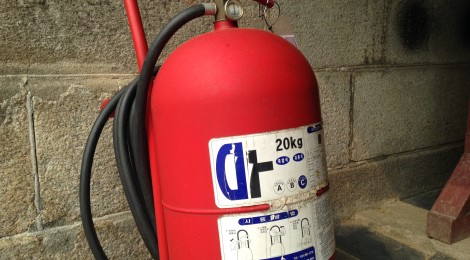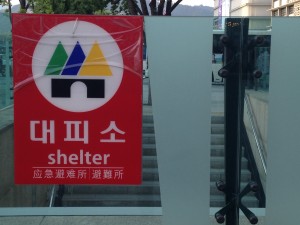
Ready! Steady! Korea!
Not even sleepwalkers, fresh off an overnight, change-planes-in-Ho-Chi-Minh-City flight from Malaysia, can miss the calling cards of Korea:
The reserved quiet that pervades public space, the smart phones, the fire extinguishers.
Oh! To be a South Korean fire extinguisher salesman!
In the long marble halls of Incheon airport, one is never out of sight of a red cylinder, its nozzle, and a sign graphically clarifying the purpose of this emergency tool.
In the immigration line, I can see six extinguishers of various sizes. All are at floor level and none are behind a door or under glass. The cultural assumption is that an emergency will require fast action and that until an emergency comes, no one will fiddle with the equipment.

An array of fire extinguishers at Jogyesa Temple temple in Seoul. Religious and Royal buildings like these are typically a wood and plaster construction and have an especially flammable history. Click the photo to enlarge.
In the Seoul subway the signs of readiness are yet more obvious, which we previously might have thought impossible: bold signs from the entrance lead down to the caches of medical supplies, gas masks, and flashlights, all in unlocked stainless steel cabinets. Of course fire extinguishers line the route.

A common sign at the entrance to a Seoul subway. I am curious about the complexity of the Chinese at the bottom. I would have predicted there was a single character for “cave” or something similar that would stand in for “civil defense.” Click the photo to enlarge.
About every tenth subway station is part of an underground mall with 10-30 stores so that common supplies like food, cooking apparatus and clothing are stockpiled in cave-like safety.
My first conclusion was to ascribe all the readiness and emergency gear to the long-standing and very real threat of military action from North Korea. After all, every Korean over seventy has conscious memory of Seoul being twice overrun by Communist forces and would have helped design and create the infrastructure we’re seeing.
But more time among the people of Korea has made me less certain about the ultimate validity of my fast conclusion.
For a while I wondered if the fire extinguishers were part of society-wide sexual fetish, but I have discarded that theory.
It’s not about sex, it’s about safety. Korean history is frequently dotted with conflagrations that scar the national psyche. Entire temples were consumed by fire during the Mongol invasions of the 1250’s and nearly every palace in Seoul burnt to the ground during the Japanese invasion of 1592. The subway is an especially fresh emotional icon for fire: in 2003 an arsonist set fire to a train in Daegu, which spread to a second train and killed one-hundred, ninety-two people. Significant safety upgrades countrywide were one positive outcome of the tragedy.
In our room at Hotel Nafore we have a fire extinguisher (Now I feel naked without one.) and kit containing an anchor, sling, and a long spool of nylon rope so that we can escape from the 9th floor by lowering ourselves out a window. What are the chances I would want to lower myself—an inexperienced non-combatant—out the window in a war zone?
It’s when I discover this makeshift, one-way elevator kit that I start thinking about Korean readiness in larger terms.

The emergency repelling kit from our hotel room. The coffee cup is provided for scale and branding. The only guidance, in Korean or English, is the red and white ‘purpose card’ leaning against the coffee cup. Perhaps more instructions are available if I remove the red sling from the black spool of nylon rope. Did some over-zealous tourist steal them? They weren’t in the white plastic container shown in the background, and they’re not attached to the stainless steel pulley/clutch on the right side of the image. Click the photo to enlarge.
While memories of the war and the effects of the war on the design of this nation are real, I am more and more convinced that the Korean predilection for large-scale order is an even deeper root for the readiness we see around every corner.
“The order of the big picture is maintained if small-scale chaos stays small,” thinks Korea. “Therefore we must always be ready to intervene in an emergency.”
If the elevator in our hotel is the belt and the stairway next to it (with decent-looking fire doors, I hasten to add) is the suspenders, then the reel of rope in our room (and in every room, I suspect) is the long piece of sturdy string you keep in your pocket because having your pants fall down is the very, very most horrible thing you can imagine.
And we are all pushed along by nightmares, aren’t we?
Observations by a man who carries water purification tablets in case of emergency,
Chris
“The United States nearly went to war with North Korea in June 1994…”
https://www.armscontrol.org/act/1997_05/sigal
I was in the Army at the time. There was much discussion about the hows and the whys and the wherefores in both classified and unclassified forums. From unclassified sources, the North Koreans are believed to be capable of bringing near-nuclear tube and rocket artillery weapons effects onto Seoul very shortly after the commencement of hostilities.
No one really knows for sure what the North Koreans are truly capable of, but the artillery barrages produced by both sides of the Korean war, some 60 years ago now, were some of the most intense ever seen on the planet. This includes WWI on the Western Front, WWII on the Eastern Front and the campaigns in the middle east. The guns and launchers are dug deeply into caves and were safe from air attack and artillery barrage during the Korean was. Some feel that only the threat of deep penetrating nuclear artillery strikes near the end of the Korean war convinced the _Chinese_ to finally agree to an armistice.
That all is still pretty fresh in my mind. Apparently it’s still on the minds of the South Koreans as well.
So many hotel rules…don’t steal the towels, don’t steal the coffee mugs, don’t steal the emergency repelling kit…don’t mess with the in-room fire extinguisher…
Am in receipt of charming cat-related objects of great value. Am wondering where you are now! Am feasting on the city of Portland while awaiting your return. Cheerio!